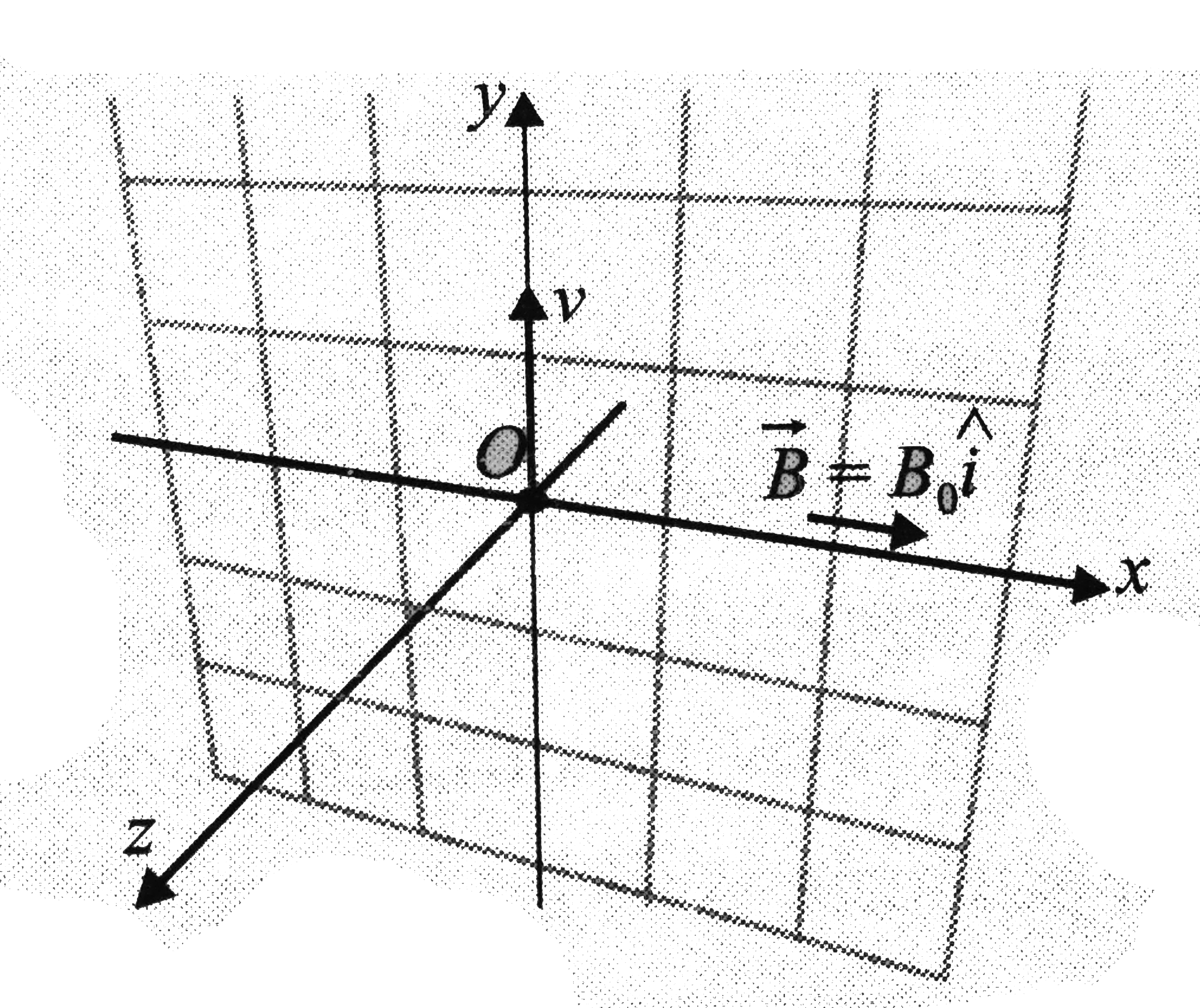In uniform magnetic field, if angle between →vand→Bis0∘<0<90∘, the path of particle is helix. Let v1 be the component of →valong→Bandv2 be the component perpendicular to →B. Suppose p is the pitch. T is the time period and r is the radius of helix. Then
T=2πmqB,r=mv2qB,P=(v1)T
Assume a charged particle of charge q and mass m is released from the origin with velocity →v=v0ˆi−v0ˆk in a uniform magnetic field →B=−B0ˆk.
Pitch of helical path described by particle is
2mv0qB0
2πmv0qB0
√2πmv0qB0
√3πmv0qB0
The correct Answer is:B
To find the pitch of the helical path described by a charged particle moving in a uniform magnetic field, we will follow these steps:
Step 1: Identify the components of velocity
The velocity vector of the particle is given as:
→v=v0^i−v0^k
From this, we can identify the components of the velocity:
- The component along the magnetic field →B (which is in the −^k direction) is:
v1=−v0(since ^k is the direction of →B)
- The component perpendicular to the magnetic field is:
v2=v0(since ^i is perpendicular to ^k)
Step 2: Calculate the time period T
The time period T of the helical motion is given by the formula:
T=2πmqB
Here, B=B0 (the magnitude of the magnetic field).
Step 3: Calculate the radius r of the helix
The radius r of the helical path is given by:
r=mv2qB
Substituting v2=v0:
r=mv0qB
Step 4: Calculate the pitch P
The pitch P of the helical path is given by:
P=v1T
Substituting v1=−v0 and the expression for T:
P=(−v0)(2πmqB)
Since we are interested in the magnitude of the pitch, we can take the absolute value:
P=v02πmqB
Final Result
Thus, the pitch of the helical path described by the particle is:
P=v02πmqB
The velocity vector of the particle is given as:
→v=v0^i−v0^k
From this, we can identify the components of the velocity:
- The component along the magnetic field →B (which is in the −^k direction) is:
v1=−v0(since ^k is the direction of →B)
- The component perpendicular to the magnetic field is:
v2=v0(since ^i is perpendicular to ^k)
The time period T of the helical motion is given by the formula:
T=2πmqB
Here, B=B0 (the magnitude of the magnetic field).
The radius r of the helical path is given by:
r=mv2qB
Substituting v2=v0:
r=mv0qB
The pitch P of the helical path is given by:
P=v1T
Substituting v1=−v0 and the expression for T:
P=(−v0)(2πmqB)
Since we are interested in the magnitude of the pitch, we can take the absolute value:
P=v02πmqB
Thus, the pitch of the helical path described by the particle is:
P=v02πmqB
Topper's Solved these Questions
- BOOK - CENGAGE PHYSICS ENGLISHCHAPTER - MISCELLANEOUS VOLUME 5EXERCISE - Integer12videos
MISCELLANEOUS VOLUME 5
- BOOK - CENGAGE PHYSICS ENGLISHCHAPTER - MISCELLANEOUS VOLUME 5EXERCISE - Multiple Correct34videos
MISCELLANEOUS VOLUME 5
- BOOK - CENGAGE PHYSICS ENGLISHCHAPTER - MISCELLANEOUS VOLUME 3EXERCISE - True and False3videos
MISCELLANEOUS VOLUME 3
- BOOK - CENGAGE PHYSICS ENGLISHCHAPTER - NUCLEAR PHYSICSEXERCISE - ddp.5.514videos
NUCLEAR PHYSICS
Similar Questions
In uniform magnetic field, if angle between →vand→Bis0∘<0<90∘, the path of particle is helix. Let v1 be the component of →valong→Bandv2 be the component perpendicular to →B. Suppose p is the pitch. T is the time period and r is the radius of helix. Then
T=2πmqB,r=mv2qB,P=(v1)T
Assume a charged particle of charge q and mass m is released from the origin with velocity →v=v0ˆi−v0ˆk in a uniform magnetic field →B=−B0ˆk.
Axis of helix is alongView SolutionIn uniform magnetic field, if angle between →vand→Bis0∘<0<90∘, the path of particle is helix. Let v1 be the component of →valong→Bandv2 be the component perpendicular to →B. Suppose p is the pitch. T is the time period and r is the radius of helix. Then
T=2πmqB,r=mv2qB,P=(v1)T
Assume a charged particle of charge q and mass m is released from the origin with velocity →v=v0ˆi−v0ˆk in a uniform magnetic field →B=−B0ˆk.
Angle between v and B isView Solution
Knowledge Check
- Question 1 - Select One
A particle of mass m and charge q has and initial velocity →v=υ0ˆj. If an electric field →E=→–––(0)ˆi and magnetic field →B=B0ˆi act on the particle, its speed will double after a time :
At=2mv0qE0Bt=2B0qmv0Ct=√3B0qmv0Dt=√3mv0qE0
A portion is fired from origin with velocity →v=v0ˆj+v0ˆk in a uniform magnetic field →B=B0ˆj. In the subsequent motion of the proton
View SolutionWrithe the component of →b along →a.
View SolutionWhat is the direction of the force acting on a charged particle q, moving with a velocity →v a uniform magnetic field →B ?
View SolutionA particle of charge q and mass m starts moving from the origin under the action of an electric field →E=E0ˆiand→B=B0ˆi with a velocity →v=v0ˆj. The speed of the particle will become 2v0 after a time.
View SolutionA particle of mass m and charge q has and initial velocity →v=υ0ˆj. If an electric field →E=→–––(0)ˆi and magnetic field →B=B0ˆi act on the particle, its speed will double after a time :
View SolutionA charge particle of mass m and charge q is projected with velocity v along y-axis at t=0.

Find the velocity vector and position vector of the particle →v(t)and→r(t) in relation with time.View SolutionChoose the correct option:
A particle of charge per unit mass α is released from origin with a velocity →v=v0ˆi in a magnetic field
→B=−B0ˆk for x≤√32v0B0α
and →B=0 for x>√32v0B0α
The x-coordinate of the particle at time t(π3B0α) would beView Solution

